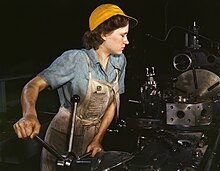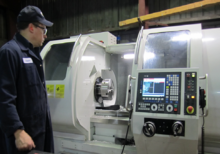Machinist
Industrial Training Institute, Apprenticeship | |
Fields of employment | Industrial manufacturing |
|---|---|
Related jobs | Millwright |

A machinist is a tradesperson or trained professional who operates machine tools, and has the ability to set up tools such as milling machines, grinders, lathes, and drilling machines.[clarification needed]
A competent machinist should have a well-developed mechanical aptitude, the ability to correctly use precision measuring instruments, interpret blueprints, and a working knowledge of the proper parameters required for successfully utilizing the various tools commonly used in machining operations. CNC (computer numerical control) is the modern manufacturing method in which machinist use a form of programming called G-code to make components for a wide variety of industries. CNC programming is a highly skilled position. Programmers are usually machinist as well. A CNC programmer creates programs using software called CAM(computer aided manufacturing). The programmer must be proficient in math, speeds and feeds, machine tooling, work holding, and the different ways various materials react to stress and heat in the machining process.
Nature of work
The machine trade is an extremely broad field with a wide variety of workplaces, job duties, and types of work. Most machinists work in machine shops and factories where they operate machinery that produce precision component parts. In general, the occupation is exacting, and requires extensive knowledge of the tools and processes in order to achieve the tight tolerances and surface finishes that these parts specify.
Many machinists make mass-produced parts using highly automated computer numerical control machines which are common today, but still require such professionals to set up and calibrate the machines. Other more specialised machinists produce custom-made parts for prototyping, repair, or research. A machinist may work on manufacturing something relatively simple like a bracket, or a shaft, or something extraordinarily complex, such as aerospace components accurate to 5 micrometres.
Good machinists are highly sought after and respected skilled trades persons and are generally well-paid. In utility, medical, and military use companies, experienced machinists can earn over $100 000 per year.
Related occupational titles
Some titles reflect further development of machinist skills such as
other related fields include Millwrights, quality assurance, and mechanical engineers.
In Australia, a related profession is a fitter and turner. A fitter and turner is the tradesperson who fits, assembles, grinds and shapes metal parts and subassemblies to fabricate production machines and other equipment.[1]
Under the machinist title are other specialty titles that refer to specific skills that may be more highly developed to meet the needs of a particular job position, such as fitter (assembles parts), turning hand, mill hand, and grinder.
Role in manufacturing

A machinist is usually called upon when a part needs to be produced from a stock material by cutting. Such a part may be unique or may be needed in the thousands. The part could be anything made from metal or plastic, though machined parts are usually ones that require high precision and cannot be produced by other means. Machinists generally start with a saw cut length of
CNC machines are becoming the standard due to their speed, precision, flexibility, repeatability, and reduced downtime while changing jobs. Production runs consisting of large numbers of parts are more cost effective and commonly referred to as production work in the trade. Conversely, small production runs are sometimes referred to as prototype or jobbing work.

Large commercial organizations often staff machinists on site in a maintenance mode to ensure continuing operations of the production machinery. Such machinists can often make replacement parts the same day. Because of this, the labor cost for this role are significantly lower than costs involved with production shutdowns.
Additive machining
Additive machining means 3D printing to create industrial components, prototypes, tooling, and end-use production parts. Additive machining comes into its own in the manufacturing of very small intricate parts, which could not be produced through any other manufacturing process. There are several processes in additive manufacturing which include direct metal deposition: electron beam melting, fused filament fabrication, select laser sintering, and variations of them.
Materials commonly encountered by machinists
The most common materials that machinists make parts from are
While the foregoing were primarily the materials that a machinist would be cutting, the cutters that the machinist uses must be harder and tougher than the materials to be cut. The materials in the cutters a machinist uses are most commonly high-speed steel, tungsten carbide, ceramics, Borazon, and diamond.[3]
Machinists usually work to very small
, to name a few.Tools of the machinist
The tools that a machinist is expected to be proficient with fall into broad categories:
- Measuring tools: The measuring tools come in several basic varieties:
- Comparison tools such as adjustable parallels and plain calipers,
- Direct reading tools such as rules, scales, and vernier calipers,
- Micrometer tools based on screw threads,
- Indicator tools based on clockworkgear movements,
- Electronic measuring tools based on caliper.[4]
- CADdrawing
- optical comparators, which magnify the silhouette of a part onto a screen so small features can be more easily inspected
- surface roughness testers,
- Comparison tools such as adjustable
- Hand tools: The hand tools are the usual complement of tools found in a complete auto mechanic's set except that auto specialty tools would be absent and some outsized tools would likely be present, such as 1 1/2" (38 mm) open end wrench.
- Deburring tools: These are tools such as die grinders, picks and blades used to remove burrsand break sharp edges often left on machined parts
- Machine tools: The machine tools have undergone a dramatic shift in the last 20 years. Manual machines have given way to computer numerically controlled machines (CNCs). For clarity's sake a categorization based on the historical groupings will be offered. Each of these groupings has been altered by the advent of CNCs and the CNCs meld some groups and blur the lines between others. The most common machine tools fall into five categories:
- Drilling machines, bench, floor, radial, and horizontal
- Milling machines, horizontal, vertical, and boring mills, 4 and 5 axis mills
- Turning machines, Swiss lathe
- Grinding machines, surface, cylindrical, centerless, universal
- Electric Discharge Machines, wire, sinker,
- Work holders: The work holders may include vises, chucks, clamps, indexing accessories, pallets, specialty jigs or fixtures, and faceplates.
- Tool holders: The tool holders may include chucks, cutter adapters, cutter extensions, tool posts, indexable turrets, box tools, quick change adapters, arbors, shrink fit, and collets.
- Cutting tools: Cutting tools include various milling cutters such as reamers, taps, countersinks, counterbores, and core drills; various turning tools, form tools, and threading tools; various grinding wheels[5]distinguished by their geometry, bond, grit size, and compound.
- Charts and reference materials: such as tap drill charts, conversion charts, thread tolerance charts, ASME and ISO specifications, machine tool manuals, and tooling feeds and speeds charts.
See also
- List of metalworking occupations
- Machinist calculator
- International Association of Machinists and Aerospace Workers
- Machining
References
- ^ "Fitter and Turners – JobOutlook". Retrieved 12 February 2022.
- ^ a b "Tool & Die Makers - Tooling Engineers | ESI Engineering Specialties Inc". ESI Engineering Specialties Inc. Retrieved 2016-02-04.
- ^ a b Fagerlund, Jaakko (2010-12-08). "Home Shop Machinist: Materials and their properties". Home Shop Machinist. Retrieved 2016-02-04.
- ^ "Useful Tools". CNCCookbook. Archived from the original on May 6, 2016. Retrieved 2016-02-04.
- ^ "10 Must-See Ideas for Cutting, Tooling, Programming, Machining, and Shop Management". americanmachinist.com. Retrieved 2016-02-04.
